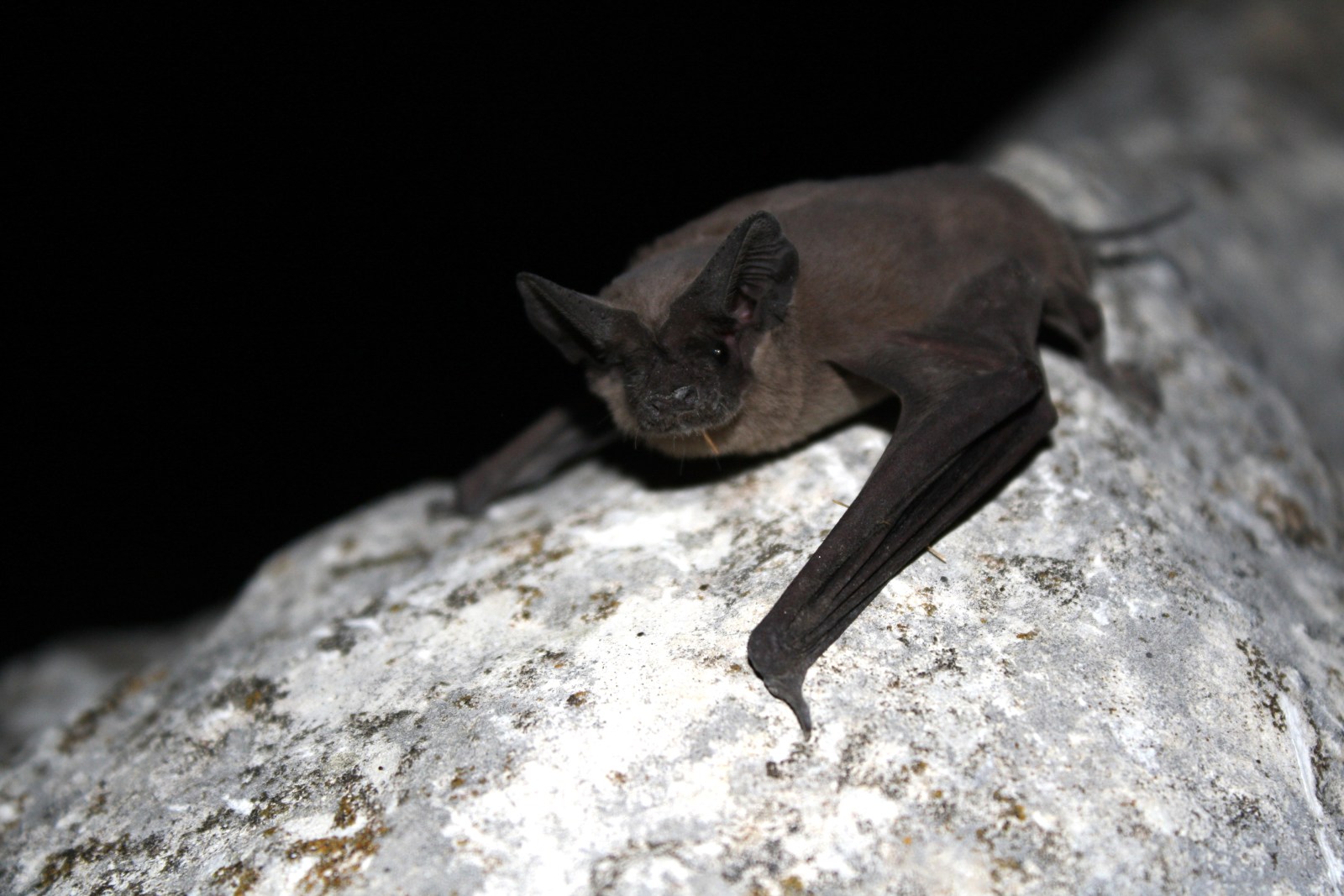It was the middle of a triple-digit heat wave in the hottest July ever recorded in Bakersfield, California. Bat biologist Erika Noel stepped beneath a freeway overpass along State Route 178, and the air felt like an oven. Forty feet above, clustered among five joints of the bridge, were thousands of Mexican free-tailed bats emitting their trademark musk—an odor laced with the smell of ammonia and corn chips. Noel spotted some clinging to the edges of the bridge, vying for cooler air. The maternity roost arrived in spring and will stay through October when they likely migrate to their wintering grounds. Just days ago, they had given birth to their annual pups, who arrived feet-first into their mothers pouches.
But at Noel’s feet over a thousand bat pups were scattered across the street, burning on the hot pavement, each barely more than an inch long. Some of their gray bodies turned red and flaky, and the smell of decaying flesh made Noel’s heart ache. She held up her hands, slowing the surge of cars rushing on and off the freeway ramps, urging them to a stop. Along with Brooke Stutz, a fellow biologist, Noel gingerly stepped between the fallen bodies and gathered into pet carriers about a dozen pups still twitching and flopping in futile efforts to return to their mothers above. But for most, it was too late. Over a thousand—all pups and juveniles—had already died.
This was the second summer Noel had rescued bats that were overheating at the Q Street intersection. Last year, only a couple hundred dropped from the roost. But this year was far deadlier. The heat wave arrived sooner and stronger, when the baby bats were not yet furred and unable to fly. Noel began picking up bats on June 27 when the first couple hundred pups fell from the roost. Over the course of six weeks, she witnessed the deaths of over a thousand bats, until they stopped dropping in late August.
Mexican free-tailed bat (USFWS/ Ann Froschauer ^(https://www.blogquicker.com/goto/https://www.flickr.com/photos/usfwshq/8006850175/in/photolist-2oDHZ7u-2oa4r5L-dcxcKT-24Q1SVy-24Q1SL5-RxNmpj-dcxcAX-2nmdbXE-24Q1RN3-8KtiXF-atYrKU-fkPdCH-fm4orm-dcxajv-dcxbiX-dcxbzj-9JrzuR-oie7PS-6NCbXV-dcxbtD-fkPgC2-dcxaXB-9uAPaL-6C8X5R-5J6JQL-8oGDDp-PHnUk-2mHtz2b-2mHuzzp-dcx9Sm-dcxcsY-dcxdss-dfZFre-dfZFxr-dcx8sW-dcx9is-dfZFt8-dcx8vT-dcxd5f-dcxc8Z-fm4p6w-dcxdkw-dfZHtA-fm4rT3-dcx92b-dcx876-dcx9zs-fkPpYB), CC by 2.0)
As natural roosts such as caves, trees, and other foliage have become rarer habitats, bats have turned to bridge and building crevices that heat up during the day and can stay warm throughout the night. In 2019, the California Department of Transportation found that 16 of 25 bat species in California roost in bridges and culverts ^(https://www.blogquicker.com/goto/https://dot.ca.gov/-/media/dot-media/programs/environmental-analysis/documents/env/caltrans-bat-mitigation-guide-a11y.pdf), and Mexican free-tailed bats are one of three species with especially high rates of roosting in these structures.
Mexican free-tailed bats can withstand temperatures from 38 to 114 degrees Fahrenheit—one of the most significant ranges for mammals. But their large body surface relative to their weight exposes the bats to dehydration, which can cause kidney failure, neurological issues, and cardiac failure. These advanced stages of overheating then cause them to fall from their roosts. The pups are particularly vulnerable because Mexican free-tailed bats have evolved to roost their young in warm environments, sometimes in the highest and hottest reaches of a cave or underpass, because it encourages rapid growth. They are estimated to pack 500 babies together in one square foot. But in the era of climate change and rising temperatures, the tendency is increasingly turning into a fatal trap.
Ten minutes away from the roost, in Noel’s climate-controlled garage in Bakersfield, she and Stutz, a registered vet technician, created an assembly line for treatment. They cleaned the pups, checked for injuries including wing fractures and respiratory difficulty, and triaged them into separate enclosures. The women injected rehydrating fluids underneath the skin of each pup with small needles, their veins too tiny to locate. This year’s bats were thin, weak, and severely dehydrated—they would need to be sent to rehabilitation facilities for longer term care, Noel says.
But not all wildlife care facilities can provide the special flight enclosures and trained volunteers with rabies vaccinations necessary for bat rehabilitation. Also a Mexican free-tailed bat has specific diet, humidity, temperature, and habitat requirements. Noel and Stutz began emailing and calling on a network of volunteers and care centers. Los Angeles Bat Rescue and Santa Barbara Wildlife Care Network were the nearest rehabilitation options and helped rescue a handful of bats last year, but northern California volunteers were already responding. Corky Quirk of NorCal bats, a volunteer bat rehabilitation center, had provided contacts and transport logistics aided by Wildcare, a wildlife rehabilitation center in San Rafael, some 300 miles from the bats.
It was already a record-breaking year at Wildcare for stranded and heat-stressed baby animals; staff and volunteers were busy attending to birds and squirrels toppling out of their nests. While Wildcare doesn’t normally receive animals from so far away, Noel’s message was urgent. “It took a little convincing,” says Melanie Piazza, Wildcare’s director of animal care. Wildcare agreed to take in 49 of the bats.
But Noel was still treating the bats in Bakersfield, unable to make the entire trip north. Wildcare coordinated the handoff on July 14, when Noel gave the 49 bats to a volunteer in Gilroy, who also happened to work as a limo driver and was on his way to drop a client at the San Francisco International Airport. Fighting through Sunday traffic, the limo driver then passed off the bats to another volunteer in Emeryville. When they arrived at Wildcare, 38 pups had survived the journey. Later that afternoon, the bats were distributed among ten volunteers.
“It’s remarkable to see how many people came together to make this happen for bats,” Noel says. “I didn’t realize that there’s more bat advocates out there.” Nearly a hundred bats were distributed between Pacific Wildlife Care in Morro Bay, Wildcare in San Rafael, Lindsay Wildlife Care in Walnut Creek, and Native Care Rescue in Santa Cruz.
Rescued bats temporarily homed in a box with blankets (Video by Rachel Griffiths)
As July and August passed, the remaining bats in care grew and needed more space. In the last month of caretaking, one volunteer with room stepped up: Rachel Griffiths. A former firefighter and volunteer bat exclusionist who removes bats from dangerous or unwanted situations, Griffiths has rehabilitated hundreds of animals for Wildcare over 20 years. She was already taking care of eight baby raccoons and two baby skunks in her backyard. In the beginning, she fostered a handful of bats in a small incubator set to about 90 degrees and 60 percent humidity. Now, all 38 bats are homed in her backyard in Sonoma.
Holding them to her chest, swaddled in pink and blue polka-dotted blankets, she feeds them individually. It takes about four hours a day. Now, she is weaning them off the formula she syringes into their mouth, or sometimes delivers with the help of a foam nipple, a blend of premature baby formula, goat’s milk, and corn oil. Instead, with cotton gloves, she sticks some 700 wriggling and defiant mealworms into the pups’ sharp-toothed mouths every day. Feeding them costs about 70 dollars a week, and all 38 bats have now doubled or tripled in size weighing up to 12 grams, about as heavy as a AAA battery. Now, half are able to fly.
Rachel Griffiths feeding mealworms and formula to baby bats at Wildcare (Photos by Jillian Magtoto)
With short fur and long, narrow wings, Mexican free-tailed bats are built for speeds up to 60 miles an hour, and can travel 100 miles in an evening looking for food. The pups, however, take five to six weeks to learn how to fly.
“They’re still uncoordinated,” Griffiths says. “I can hear them hit the ground, and they scamper up the wall and they take off again. Right now, they are learning to land.”
Wildcare is preparing to return the bats to their Bakersfield roost by the end of September, when all of the pups are capable of flying. “It’s just one of the realities that we have to deal with in this line of work,” says Piazza. “The best thing for them is to go back to where they came from; that’s where all of their genetics are. We have to hope for the best.” Translocating—capturing and moving—wildlife is illegal in California and generally discouraged by Federal and State wildlife agencies, and for good reason. The bats’ colonial and cryptic nature, roost requirements, and potential disease transmission, make for unlikely and difficult translocation. Researchers have also found that Mexican free-tailed bats prefer the calls of their own pups, each with their own distinct sounds of varied pulses and harmonics. While uncertain, their return may mean a reunion with their mothers.
Since Noel was young, she was drawn to the bats that flew around her ranch and has dedicated her career, and summer vacation days, towards protecting an often overlooked species. Noel plans to stay in Bakersfield and continue monitoring the roost, and is now consulting for the California Department of Transportation to come up with a strategy to prepare for another possible heat wave, one that seems sure to come. By 2050, the city is predicted to face more heat waves and an average of 33 days per year reaching over 104.6 degrees.
“With two years of extreme heat conditions, I don’t know if the colony will move to a different roost or not,” says Noel. “We’ll see, but I will be checking on it next year.”
Sign up today! ^(https://www.blogquicker.com/goto/https://baynature.org/sign-up-for-connections/)

#Normal #Hot #Bats #Drop #Thousands



